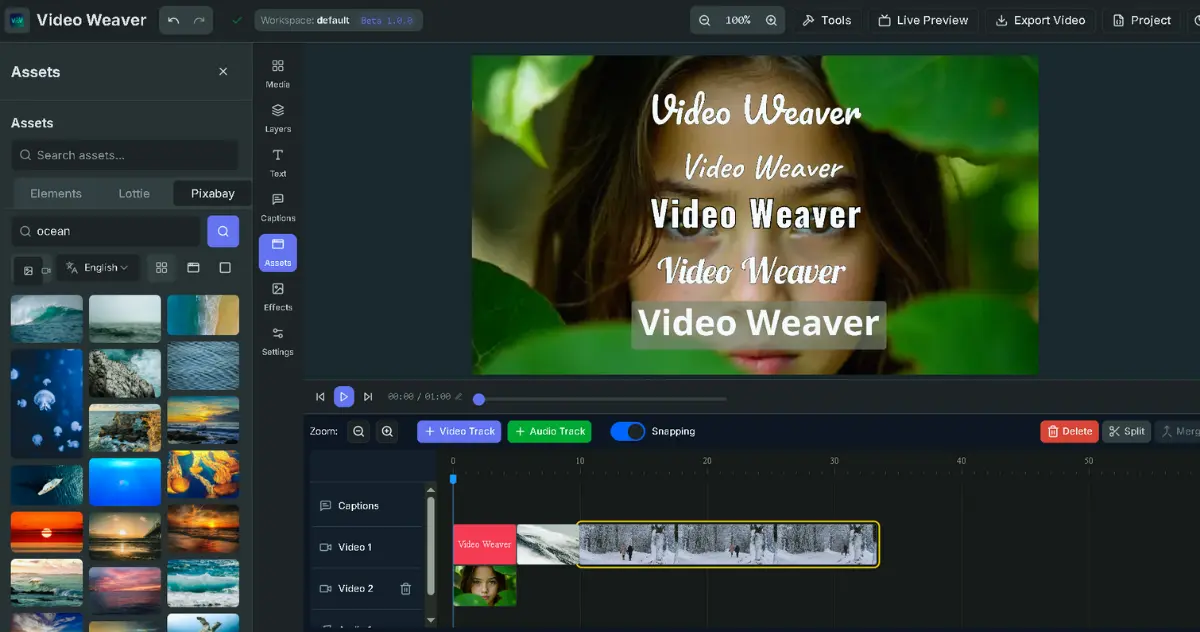Tired of narrow 3D scene generation? The open-source Matrix-3D model from Skywork AI, through innovative panoramic video generation technology, allows you to create a grand 3D world that can be freely explored in 360 degrees from a single image or sentence. Let’s see how powerful this new favorite in the AI world is!
Have you ever imagined that one day, with just a sentence or a picture, you could create a virtual world exclusive to you, where you can roam freely? This sounds like a plot from a science fiction movie, but now, this dream is being turned into reality by an AI model called Matrix-3D.
Recently, this open-source project launched by Skywork AI has caused quite a stir in the AI community and developer circles. Matrix-3D is not the kind of ordinary model that can only generate a static image or a short video with a fixed perspective; its goal is much more ambitious - to directly generate a vast, seamless 3D world that you can freely explore in 360 degrees. This means that AI is not just a drawing tool, it is evolving into a “world simulator”.
No Longer Just “Looking”, But Truly “Walking In”: What’s Different About Matrix-3D?
In the past, many AI 3D generation technologies were like letting us peek into a virtual scene through a small window. You could see the scenery outside the window, but you couldn’t turn around to see what was behind you, nor could you go around to the other side of the building. The generated scene was limited in scope, and once you exceeded the preset perspective, annoying boundaries or distortions would appear, greatly weakening the sense of immersion.
Matrix-3D completely changes the rules of the game. It adopts “panorama” as its core idea, with the goal of creating a space that you can truly “walk into”. This is like upgrading from looking at a landscape photo to wearing a VR headset and walking in that world yourself.
So what’s so great about this model? There are several amazing features:
- Vast and Unbounded Scenes: Compared with existing models on the market (such as WorldLabs), Matrix-3D can generate larger and more complete virtual environments, allowing you to break free from the constraints of perspective and achieve true 360-degree omnidirectional exploration.
- Ultra-High Degree of Freedom Control: It not only supports text and image input, but also allows you to customize the camera’s movement trajectory. Imagine that you can, like a director, command the AI to generate a scene video flying along a specific route, and then turn it into a 3D space that can be freely explored.
- Powerful Generality: Based on the team’s self-developed 3D data and video models, Matrix-3D can generate diverse and high-quality scenes, whether it’s a fantasy floating island or an impressionist-style winter snow scene, it can do it with ease.
How to Have Your Cake and Eat It Too? Matrix-3D’s “Dual-Track” Reconstruction Magic
In the field of 3D generation, there has always been a difficult problem: generation speed and model quality seem to be difficult to have both. Either quickly generate a rough model, or spend a lot of time waiting for a detailed work.
Matrix-3D cleverly solves this problem with a “dual-track” design, providing users with two choices:
Fast and Accurate “Feed-forward Reconstruction Model”: This can be understood as the “speed first” mode. It uses a large reconstruction model to directly predict and restore 3D attributes from the generated panoramic video. This process is very efficient, and can complete the 3D scene reconstruction in as little as 10 seconds. When you need to quickly preview the effect or perform multiple iterations, this mode is simply a godsend.
Meticulous “Optimization-based Pipeline”: This is the “quality first” mode. It will perform detailed optimization for a single scene to ensure that the accuracy and details of the model reach the highest level. Although it takes longer, the result is amazing visual effects and geometric accuracy.
To make an analogy, it’s like you have both a sketch artist who can quickly outline a sketch and an oil painting master who can meticulously carve it. You can choose the most suitable tool at any time according to your needs.
AI Also Needs to Go to School: The Behind-the-Scenes Story of the Matrix-Pano Dataset
As the saying goes, a great teacher produces a brilliant student. No matter how powerful an AI model is, it needs massive, high-quality data for training. When developing Matrix-3D, the research team encountered a tricky problem: there was no dataset on the market that fully met their needs.
Existing 3D datasets are either not large enough in scale or of uneven quality. More importantly, they generally lack key annotation information such as camera trajectories and depth maps.
What to do? If there isn’t one, then create one yourself!
Thus, the Matrix-Pano dataset was born. This is a large-scale synthetic panoramic video dataset containing more than 116,000 high-quality static panoramic video sequences. Each video is equipped with precise 3D exploration trajectories, depth maps, and text annotations, which can be called a “textbook” born for training 3D world models. This dataset not only made Matrix-3D a success, but it also became a major contribution to the entire AI community.
Can I Play Too? Hardware Threshold and Future Prospects of Matrix-3D
Seeing this, you must be eager to try it, right? However, to drive such a powerful world model, the hardware requirements are naturally not low.
According to the official information, generating a 480p resolution scene currently requires 40G of video memory (VRAM), while 720p requires as much as 60G. This is indeed a high threshold for most ordinary users.
But the good news is that the Skywork AI team has promised to release a lighter model version soon, which will only require 24G of VRAM (such as an NVIDIA RTX 4090 graphics card) to run 720p generation tasks. This means that soon, more developers and creators will be able to experience the fun of creating worlds on their own computers.
If you have the right hardware and want to try it right away, you can go to the official GitHub and Hugging Face pages. The official provides very detailed installation and use guides, and even a one-click generation script, which greatly reduces the difficulty of getting started.
Summary
The open source of Matrix-3D is not just the release of an interesting tool, it is more like a declaration, declaring that a new era of AI-generated content has arrived. It allows us to see that AI is transforming from a content generator to an environment simulator and a world builder.
As world models like Matrix-3D continue to develop and become popular, we have reason to believe that in the near future, everyone can become the “creator” of their own virtual world. Whether it is creating game scenes, producing film and television special effects, or building the cornerstone of the metaverse, this technology will release infinite potential.




